![]()
|
xtreview is your : Video card - cpu - memory - Hard drive - power supply unit source |
|
|
|
|
||
|
POSTER: computer news || SYNOPSYS INTRODUCES TOOLKIT FOR INTEGRATION INTO SOC CONTROLLERS HBM2 |
DATE:2017-07-28 |
|
The memory of HBM2 has good prospects in the composition of high-performance platforms. In comparison with DDR4 memory, the speed of working with HBM2 memory is more by an order of magnitude. Modern DDR4 specifications allow for exchange at speeds of 3200 Mbit / s, and HBM2 chips can provide up to 307 GB / s throughput, which is 12 times more. It is this bandwidth that will allow HBM2 controllers, which can be designed using the new Synopsys tool package. 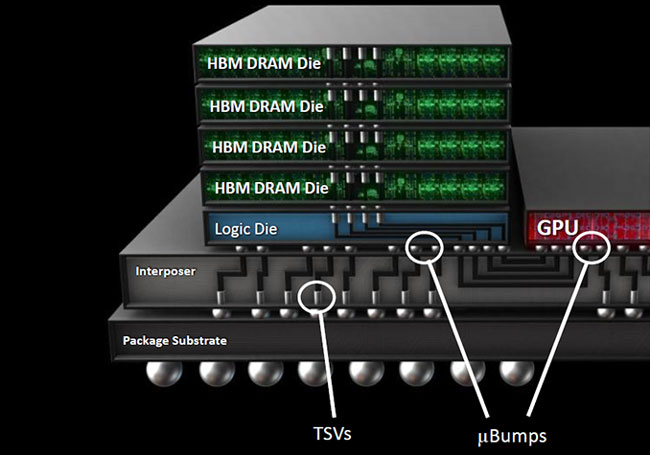
The developer of the tools for digital design reported that he began to distribute the complete set of design tools (DesignWare) of HBM2 controllers. The kit includes controller design, physical layer design, and tools for testing and self-testing of designed solutions. The presented kit allows with less effort and as soon as possible to integrate the HBM2 controllers into the composition of any single-chip assembly or processor. This will speed up the appearance of interesting graphics processors and high-performance server-based processors. Synopsys tools allow you to create a HBM2 controller with a bandwidth that is 20% more than the JEDEC standard (that would be where memory manufacturers provided the HBM2 bandwidth!). The standard prescribes a maximum data transfer rate of 2000 Mbit / s per contact. Synopsys design tools guarantee the operation of controllers at speeds up to 2400 Mbit / s per contact. In addition, the HBM2 controllers, designed with the help of the corresponding Synopsys package, support all the innovations provided by the HBM2 standard, including four consumption modes (for power savings) and pseudo-channel data bus addressing. The breakdown of data access channels into pseudo channels is quite an important innovation, which became available with the advent of HBM2 specifications. This allowed to increase the speed of memory access with two crystals in the stack. According to the original standard, only two 128-bit channels can be connected to each crystal in the stack. In the case of a four-chip stack, the entire available HBM (2) bus is 1024 bits wide, but for a stack of two crystals, half of the channels remain in the "air" and does not work for the throughput of the chip. In the pseudo-channels (software emulation) mode, each 128-bit channel is divided into two 64-bit channels, which doubles the number of working channels for data access and increases the access speed of small-capacity HBM2 memory (with the minimum number of chips in the stack). Synopsys tools for the design of the HBM2 controller have already been used by AMD designers who, with their help, integrated the controller into the graphics processor on the Vega architecture. The result reportedly met expectations. The key to the success of the new Synopsys tools is the widely-used experience from the previous development of the design tools and memory controllers HBM of the first generation and DDR4 memory. Select Rating :Synopsys Introduces Toolkit for Integration into SoC Controllers HBM2 |
Add Comment ( 1 ) SYNOPSYS INTRODUCES TOOLKIT FOR INTEGRATION INTO SOC CONTROLLERS HBM2 |
|
|
|
|
POSTER: computer news || INTELS QUARTERLY REPORT ABOUNDS WITH ILLUSTRATIONS |
DATE:2017-07-28 |
|
Reporting for the results of its activities in the second quarter this year, Intel reformed the documentation of this process: the press release began to contain more well-structured tables, and the traditional comments of the CFO are now illustrated with colorful slides. 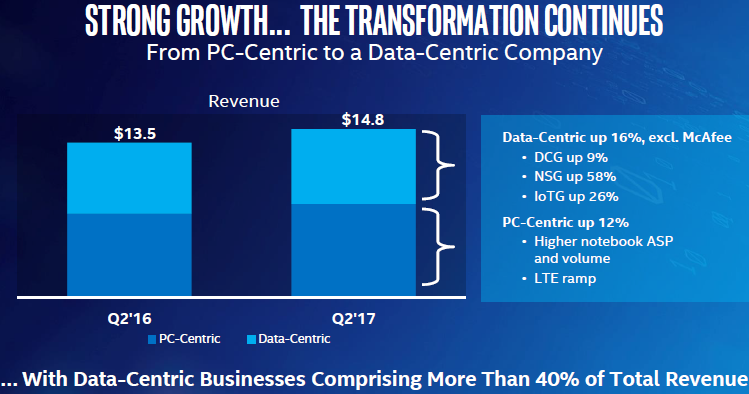 First, Intel is trying to convince investors and shareholders that it is less and less dependent on the falling PC market, although in the promising areas of activity the company receives slightly more than 40% of revenue, and so far its welfare still largely depends on the success in the personal computer market. If not for the costs of McAfee, then Intel's revenue would grow by 16% in the second quarter compared to the same period last year. Growth rates in "promising directions" are measured by tens of percent, but in the segment of PCs we have to call "revenue locomotives" the increased average selling price and sales volumes of components for laptops, as well as LTE-modems. Now it's clear why Intel is so fiercely attacking Qualcomm, which prevents it from gaining a place in the market of modem solutions for smartphones. 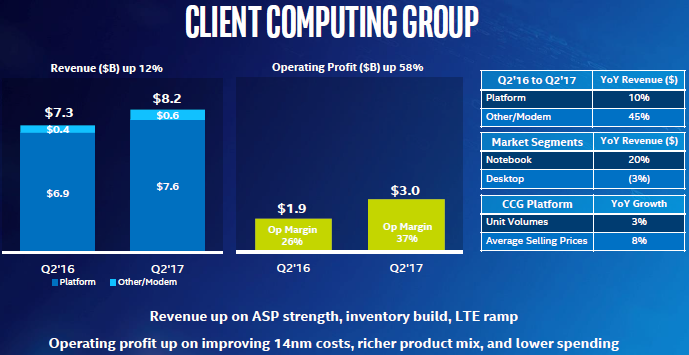 To be more precise, the revenue from the sale of components for laptops grew by 20% compared to the second quarter of last year, but from the sale of desktop processors Intel gained 3% less money! In-kind sales of components for client systems grew by 3%, and the average selling price rose by 8%.
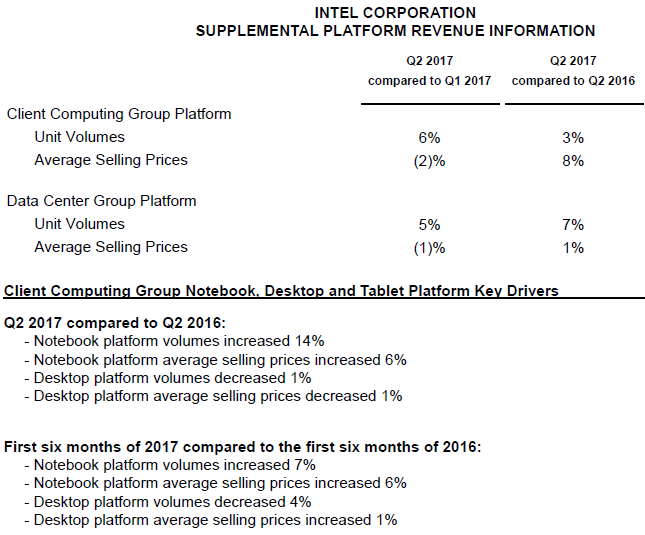 "The collapse of Intel" in the desktop segment is expressed not only in a 1% decrease in the volume of implementation of processors, but in reducing the average selling price by the same amount. Meanwhile, before that, Intel on almost every quarterly report was proud of the fact that Core processors are becoming more popular, and this helps to raise the average selling price. But we will talk about the interpretation of the new trends by Intel management today, but for the time being it should be noted that the sales of components for laptops grew by 14%, and their average price increased by 6%. 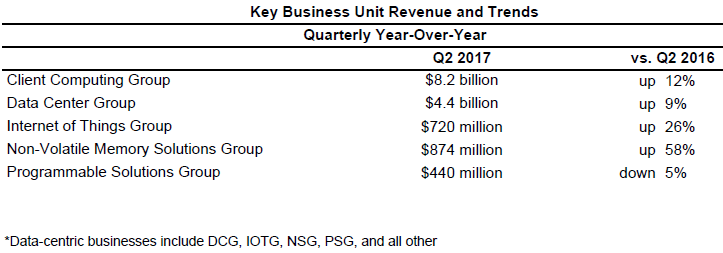 The dynamics of revenue change in the areas of Intel activities you can learn from the contents of the table above. The operating profit or loss is shown in the following table: 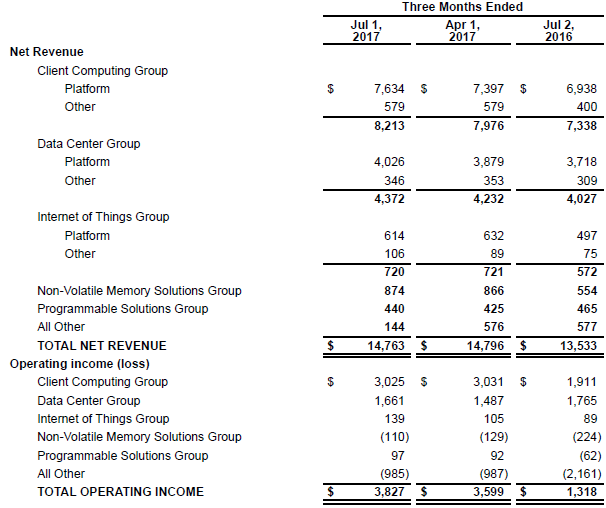 As you can see, the release of NAND memory still brings losses to Intel, but the company explains this by increasing the volume of output and expansion of 3D XPoint, but by the end of the year the company plans to get rid of losses in this direction and maintain profitability throughout 2018. In fact, the bulk of Intel's memory business came out on payback in the second quarter.
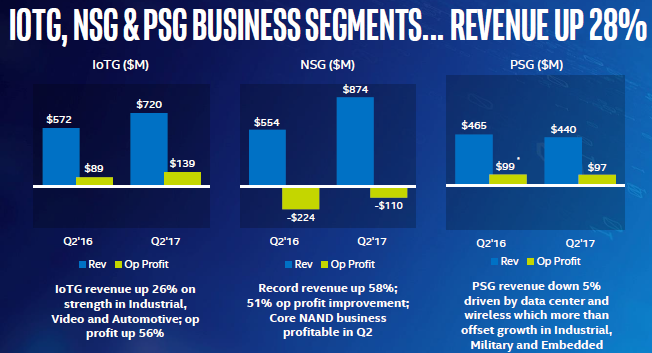 Now we will take a critical look at Intel's "spending budget". By the end of the decade, the corporation hopes to reduce the ratio of costs and revenues to 30% against the current 34-35%, and development costs are being reduced now. 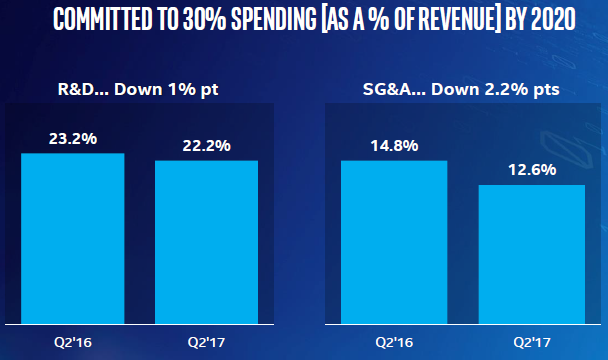 However, administrative expenses decrease faster, and the absolute value of the sums spent by Intel on R & D can not be called modest: 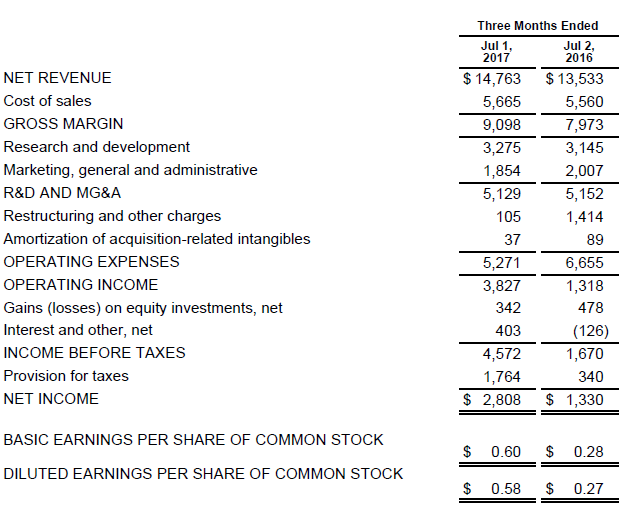 Three-odd billion dollars a quarter - this money can still be turned around, even with all his might trying to extend the "Moore law", which Intel management quite openly classifies as priorities in the allocation of costs. Select Rating :Intels quarterly report abounds with illustrations |
Add Comment ( 1 ) INTELS QUARTERLY REPORT ABOUNDS WITH ILLUSTRATIONS |
|
|
|
|
POSTER: computer news || THE BULK OF 10-NM PROCESSORS INTEL WILL APPEAR NEXT YEAR |
DATE:2017-07-28 |
|
One of the main statements of Intel management at this event we consider explanations regarding the specifics of the market launch of 10-nm processors, which should be submitted before the end of this year, and now they are already supplied in the form of engineering samples. The level of output of the products at this stage, according to representatives of Intel, increases in full accordance with the expectations of the company, although it does not do without difficulties. Although the first serial 10-nm processors will be introduced by the end of the year, their mass deliveries will begin only in early 2018, and not only in limited quantities, but also in a trimmed assortment. But in 2018, Intel promises to not only increase the volume of supplies of 10-nm processors, but also expand the range of models in the direction of more complex and productive. The head of the company did not specifically focus on what kind of processors they will be, but from previous leaks about the manufacturer's plans, we know that we are talking about mobile models. At least, they will start to master the market. Select Rating :The bulk of 10-nm processors Intel will appear next year |
Add Comment ( 1 ) THE BULK OF 10-NM PROCESSORS INTEL WILL APPEAR NEXT YEAR |
|
|
|
|
POSTER: computer news || INTEL AGGRESSIVELY RESPONDS TO RYZEN ANNOUNCEMENT |
DATE:2017-07-28 |
|
As we noted today, in the desktop segment in the second quarter, Intel not only reduced the sales of processors, but also lost in the average selling price, for the first time in a long time. Brian Krzanich said that revenue for the second quarter reached a record high, and the number of desktop and mobile processors sold outperformed Intel's own projections over the period. The share of Core processors in the sales structure continues to grow, and if earlier the inflow was due to the refusal of Atom and Pentium customers, now the processors of the older segments Core i5 and Core i7 are more actively purchased. In addition, the emergence of the Core i9 family the company's management calls correct and timely. The average price for the implementation of processors, according to Intel CEO, is not increasing due to a regular price increase. Just customers buy more expensive processors. As the company's CFO emphasized, "customers increasingly value productivity." In the first half of the year, the operating margin in this business grew by more than 50%. The emergence of the Core i9 family in Intel is called the fruit of "proper segmentation." Intel does not hide the fact that it was forced by AMD company to hurry up with the announcement of Core i9. According to Intel CEO, "really raised the bar slightly after the release of her new products." But working in a highly competitive environment and aggressively responding to challenges is familiar to Intel, so the company's management is convinced of its ability to offer products with an adequate level of performance in counterbalance to the actions of competitors. Select Rating :Intel aggressively responds to Ryzen announcement |
Add Comment ( 1 ) INTEL AGGRESSIVELY RESPONDS TO RYZEN ANNOUNCEMENT |
|
|
|
|
xtreview is your : Video card - cpu - memory - Hard drive - power supply unit source |
|
|
|
|
||
![]()
To figure out your best laptops .Welcome to XTreview.com. Here u can find a complete computer hardware guide and laptop rating .More than 500 reviews of modern PC to understand the basic architecture


7600gt review
7600gt is the middle card range.
We already benchmarked this video card and found that ...

 geforce 8800gtx and 8800gts
geforce 8800gtx and 8800gts  Xtreview software download Section
Xtreview software download Section  AMD TURION 64 X2 REVIEW
AMD TURION 64 X2 REVIEW  INTEL PENTIUM D 920 , INTEL PENTIUM D 930
INTEL PENTIUM D 920 , INTEL PENTIUM D 930  6800XT REVIEW
6800XT REVIEW  computer hardware REVIEW
computer hardware REVIEW  INTEL CONROE CORE DUO 2 REVIEW VS AMD AM2
INTEL CONROE CORE DUO 2 REVIEW VS AMD AM2  INTEL PENTIUM D 805 INTEL D805
INTEL PENTIUM D 805 INTEL D805  Free desktop wallpaper
Free desktop wallpaper  online fighting game
online fighting game  Xtreview price comparison center
Xtreview price comparison center 

- 233 - E8600 vs q9400 which is better dual or quad core
Date : 2008-11-21
- 216 - Intel core 2 duo e6550 review and overclocking
Date : 2007-08-03
- 212 - Intel core 2 extreme qx6850 and core 2 duo e6850 review benchmark and overclocking
Date : 2007-07-16
- 205 - Amd athlon x2 be review , overclocking and energy consumption test
Date : 2007-06-05
- 229 - Radeon hd 4670 vs geforce 9500 gt vs geforce 9800 gt vs hd 4850 overclock benchmark and review
Date : 2008-10-10
- 228 - Crossfire hd 4870 x2 vs crossfire hd 4870 review and benchamrk
Date : 2008-09-26
- 226 - Amd radeon hd 4870 x2 2x1gb xtreview exclusive review
Date : 2008-07-14
- 220 - Nvidia 9600 gt review and benchmark
Date : 2008-02-27
- 131 - 500 to 750 gig hdd round up : maxtor wd seagate hitachi
Date : 2006-07-10
- 65 - Raptor x hdd western digital review overview : pcmark - benchmark - test
Date : 2006-05-06
- 193 - Asus s6fm-1p039e vs sony vaio vgn-g11xn/b vs lenovo 3000 v100 review and benchmark
Date : 2007-05-11
- 172 - Apple imac 20 inch - intel core 2 duo review
Date : 2007-01-26
- 102 - Toshiba tecra a6-s513 review notebook performance benchmark
Date : 2006-06-09
- 101 - Sony vgn-fj1sr review notebook performance benchmark
Date : 2006-06-09
SnagIt v.9.1.22009-04-24
Daemon Tool v.4.30.42009-04-24
WinSCP v.4.1.92009-04-24
Vista Codec Package v.5.2.02009-04-24
Vista Codec x64 Components v.1.8.12009-04-24
Anti-keylogger v.9.2.12009-04-24
Portable Firefox v.3.0.92009-04-24
AVG Internet Security v.8.5.322a14952009-04-24
Universal Viewver v.4.0.02009-04-24
Wise Disk Cleaner v.4.242009-04-24
FeedDemon v.3.0.0.16 Beta2009-04-24
SiSoft Sandra 2009 SP2 (2009.5.15.96)2009-04-24
Atheros AR5xxx Driver v.7.7.0.2332009-04-24
Bios update for 24 April2009-04-24
AIMP Classic v.2.60 Build 466 Beta 12009-04-23
SpeedFan v.4.382009-04-23
- The new version of GPU-Z finally kills the belief in the miracle of Vega transformation
- The motherboard manufacturer confirms the characteristics of the processors Coffee Lake
- We are looking for copper coolers on NVIDIA Volta computing accelerators
- Unofficially about Intels plans to release 300-series chipset
- The Japanese representation of AMD offered monetary compensation to the first buyers of Ryzen Threadripper
- This year will not be released more than 45 million motherboards
- TSMC denies the presentation of charges from the antimonopoly authorities
- Radeon RX Vega 64 at frequencies 1802-1000 MHz updated the record GPUPI 1B
- AMD itself would like to believe that mobile processors Ryzen have already been released
- AMD Vega 20 will find application in accelerating computations
- Pre-orders for new iPhone start next week
- Radeon RX Vega 57, 58 and 59: the wonders of transformation
- ASML starts commercial delivery of EUV-scanners
- The older Skylake processors with a free multiplier are removed from production
- Meizu will release Android-smartphone based on Helio P40
- AMD Bristol Ridge processors are also available in American retail
- The fate of Toshiba Memory can be solved to the next environment
- duo GeForce GTX 1080 Ti in GPUPI 1B at frequencies of 2480-10320 MHz
- New Kentsfield overclocking record up to 5204 MHz
- Lenovo released Android-smartphone K8
Affiliates



computer news computer parts review OLD Forum Downloads New Forum Login Join Articles terms Hardware blog Sitemap myspace proxy Get Freebies







